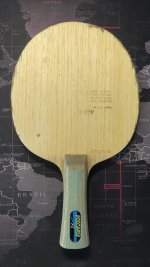TTmonster - When the tuner is available I will make an announcement. I am still trying to find the right can for the job
Carl - Although I never was highly rated player (only reached around 1800 US rating), I spent a significant amount of time working around and training with national and world class players. Further, I designed equipment for players in the top 100 in the world, including blades, rubber, speed glue and booster. For example, I was a technical coach for the 1992 US Olympic table tennis team and developed the world's first computer controlled table tennis robot in conjunction with Simplicity Tool of Oregon. I was the person who ran the drills for Sean O'Neill and Jimmy Butler. Although my rating was not very high, my technique was fairly advanced, as this was needed to test equipment. On occasion these skills allowed me to have some big upsets. Perhaps the biggest was my win over a fellow New Yorker to you, Tahl Leibowitz. We had a very famous "grudge match" many years ago, which I won. Tahl was around a 2300 US rated player at the time. I still practice with a fairly high quality player, John Thach Tran, who typically has a 2400 US rating. I think at that level one can really see the difference in tuned versus not tuned rubber. Even at my level I can feel a huge difference in my game playing against Thach. It is perhaps worth 500 rating points for me, which is a huge jump. That is am around a 1500 player without the tuner and my technique jumps to around 2000 with the tuner.
I think the 2700+ players are really affected by the "glue ban". One has to only look at the problems Fan Yi-Yong of the USA is having to know this is the case. Perhaps it is worse for older players who trained for many years with speed glued rubber. The difference is dramatic. But it is not suited for lower level players as has been stated by others.
Anyway I believe many will enjoy playing with the tuned rubber. I have worked hard to get a balance increase of speed and spin. Fortunately, I have a considerable amount of experience in speed glue/booster formulations and even have a US patent years ago on this (see US patent 5910528).
I would really appreciate it if those who claimed they know what's in the Dandoy can confirm it contains 95% paraffin oil.
Thanks
 , isn't it simple ? If your car can do the parallel parking for you, you won't ever learn, or lose your skill by the day ?
, isn't it simple ? If your car can do the parallel parking for you, you won't ever learn, or lose your skill by the day ?











